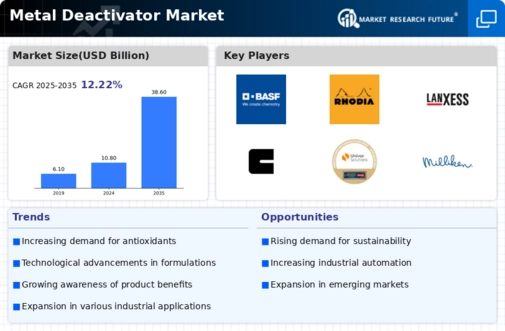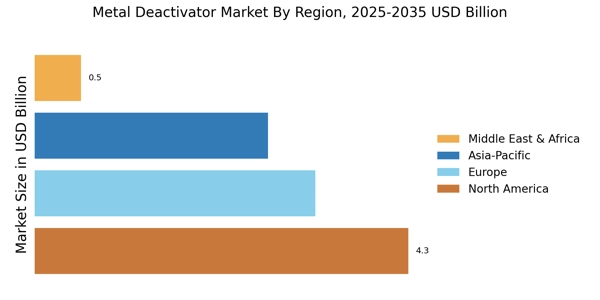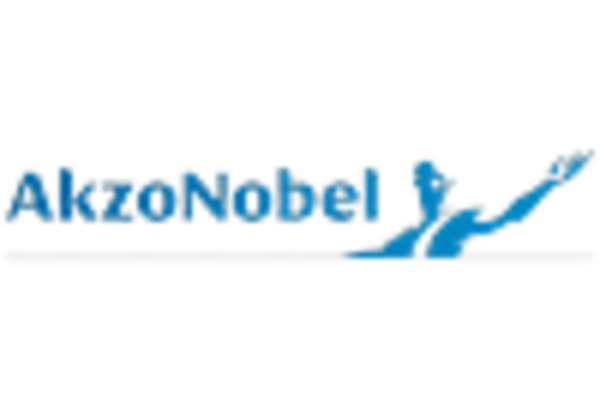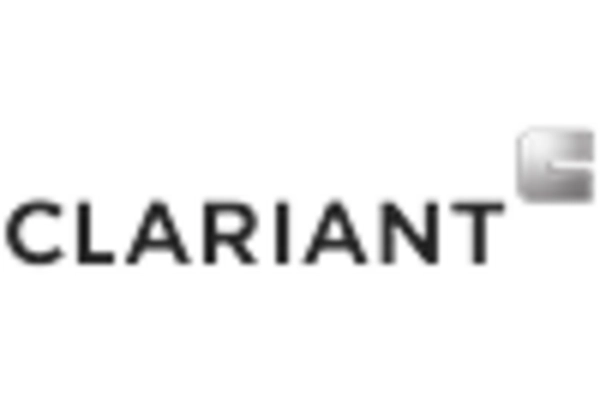Stringent Regulatory Standards
The Metal Deactivator Market is increasingly influenced by stringent regulatory standards aimed at ensuring product safety and environmental protection. Governments and regulatory bodies are implementing more rigorous guidelines regarding the use of chemical additives in various applications. This trend is compelling manufacturers to comply with these regulations by adopting safer and more effective metal deactivators. As a result, the market is likely to see a shift towards products that not only meet regulatory requirements but also offer enhanced performance. The growing emphasis on compliance is expected to drive innovation within the Metal Deactivator Market, as companies strive to develop formulations that align with evolving standards.
Expansion of the Automotive Sector
The Metal Deactivator Market is poised to gain from the expansion of the automotive sector, which is increasingly focusing on advanced materials and formulations. As vehicles become more sophisticated, the need for effective metal deactivators in engine oils and other automotive fluids is becoming more pronounced. The automotive lubricants market is expected to reach a valuation of over 60 billion dollars by 2026, indicating a robust growth trajectory. This expansion is likely to drive demand for metal deactivators, as they play a vital role in enhancing the stability and performance of automotive fluids, thereby ensuring optimal engine performance and longevity.
Rising Demand for High-Performance Lubricants
The Metal Deactivator Market is experiencing a notable increase in demand for high-performance lubricants, which are essential in various industrial applications. As industries strive for enhanced efficiency and longevity of machinery, the incorporation of metal deactivators in lubricant formulations becomes crucial. This trend is driven by the need to prevent metal-induced degradation, which can lead to significant operational costs. According to recent data, the lubricant segment is projected to grow at a compound annual growth rate of approximately 4.5% over the next five years. Consequently, the Metal Deactivator Market is likely to benefit from this growth, as manufacturers seek to improve product performance and reliability.
Increased Focus on Product Quality and Performance
In the Metal Deactivator Market, there is a growing emphasis on product quality and performance across various sectors, including oil and gas, manufacturing, and food processing. Companies are increasingly recognizing the importance of using high-quality additives, such as metal deactivators, to enhance the stability and shelf life of their products. This trend is supported by the rising consumer awareness regarding product efficacy and safety. As a result, manufacturers are investing in research and development to formulate superior metal deactivators that meet stringent quality standards. This focus on quality is expected to propel the Metal Deactivator Market forward, as businesses seek to differentiate their offerings in a competitive landscape.
Technological Innovations in Chemical Formulations
The Metal Deactivator Market is witnessing a surge in technological innovations that are transforming chemical formulations. Advances in chemical engineering and material science are enabling the development of more effective and environmentally friendly metal deactivators. These innovations are not only improving the performance of existing products but also paving the way for new applications across various industries. For instance, the introduction of bio-based metal deactivators is gaining traction, as companies aim to reduce their environmental footprint. This shift towards sustainable formulations is likely to enhance the competitive landscape of the Metal Deactivator Market, attracting new players and fostering collaboration among existing manufacturers.


















Leave a Comment